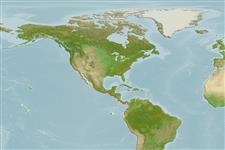Environment: milieu / climate zone / depth range / distribution range
Ecologia
marinhas; estuarina demersal; intervalo de profundidade 1 - 35 m (Ref. 9294). Tropical; 25°N - 3°S
Eastern Pacific: Mexico to Ecuador. The Seychelles record in Smith & Smith 1963 (Ref. 1623) was based on the type specimen of Symphurus seychellensis which was previously recorded as coming from Seychelles; the correct type locality for the species is northern Peru (Ref. 26282).
Tamanho / Peso / Idade
Maturity: Lm ? range ? - ? cm
Max length : 18.6 cm SL macho/indeterminado; (Ref. 9294); common length : 15.0 cm SL macho/indeterminado; (Ref. 9294)
Descrição breve
Chaves de identificação | Morfologia | Morfometria
Espinhos dorsais (total) : 0; Raios dorsais moles (total) : 96 - 104; Espinhos anais: 0; Raios anais moles: 79 - 87; Vértebras: 50 - 54.
Found on sandy and muddy bottoms, frequently in estuaries and inlets (Ref. 9294).
Life cycle and mating behavior
Maturities | Reprodução | Spawnings | Egg(s) | Fecundities | Larvas
Munroe, T.A., F. Krupp and M. Schneider, 1995. Cynoglossidae. Lenguas, lenguetas. p. 1039-1059. In W. Fischer, F. Krupp, W. Schneider, C. Sommer, K.E. Carpenter and V. Niem (eds.) Guia FAO para Identification de Especies para lo Fines de la Pesca. Pacifico Centro-Oriental. 3 Vols. FAO, Rome. (Ref. 9294)
Categoria na Lista Vermelha da IUCN (Ref. 130435)
Ameaça para o homem
Harmless
Utilização humana
Pescarias: sem interesse
Ferramentas
Relatórios especiais
Descarregue XML
Fontes da internet
Estimates based on models
Preferred temperature (Ref.
123201): 25.9 - 29.1, mean 28 °C (based on 149 cells).
Phylogenetic diversity index (Ref.
82804): PD
50 = 0.5000 [Uniqueness, from 0.5 = low to 2.0 = high].
Bayesian length-weight: a=0.01445 (0.00647 - 0.03228), b=3.05 (2.85 - 3.25), in cm total length, based on LWR estimates for this (Sub)family-body shape (Ref.
93245).
Nível Trófico (Ref.
69278): 3.4 ±0.4 se; based on size and trophs of closest relatives
Resiliência (Ref.
120179): Elevada, tempo mínimo de duplicação da população menor que 15 meses (Preliminary K or Fecundity.).
Fishing Vulnerability (Ref.
59153): Low vulnerability (13 of 100).
